NIUATOPUTAPU
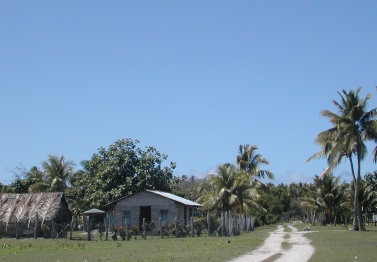
Typical village scene in Vaipoa
We were very happy to arrive at Niuatoputapu after our miserable and thankfully short passage from Western Samoa. The channel in to the anchorage is narrow, and there are breakers on both sides, but it is extremely well marked. There were two other boats in the spacious anchorage, so we had plenty of room to settle in. Tackless II came in shortly behind us.
Checking in was a “different” experience, but we did get checked in. We got the boat put back together, we got ourselves cleaned up, and we slept briefly. We had both been looking forward to Tonga, and we were excited to finally be here.
Shortly after dark we heard an outboard engine approach us, and then we heard a woman’s voice hailing us. This was how we met Sia. There were a few men holding their fishing boat off of ours, and Sia was sitting on the bow holding a large basket of fruit. She introduced herself and offered us fresh fruit. She gave us breadfruit, bananas, oranges, papaya, and limes. We asked what we could give her in return, and she said they needed some outboard oil. We had some to spare, so we gave it to her.
The next day we went ashore with Don and Gwen of Tackless II to go pay our fees. We went ashore at the wharf which is in the easternmost village of Falehau, and we walked through the village of Vaipoa to get to the government offices in the village of Hihifa. There are three villages on the island, and in less than an hour we had done a walk-through of each.
Niuatoputapu is a relatively undeveloped island. The only electricity is from a few generators mostly to power water pumps that supply one water faucet to most houses. There is no indoor plumbing, and all water remains outside. Toilets are in outhouses, and very few houses have any bathing/showering facilities. Cooking is done outside over wood fires. Surprisingly, though, many residents have a telephone – a new luxury in recent years.
Although we were originally taken by the physical beauty and quaint charm of Niuatoputapu, we soon found that its beauty and charm are dwarfed by the friendliness of its people. We made friends here that we will remember long after we sail over the horizon.
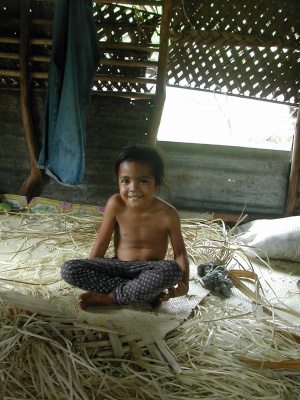
One of many beautiful local children
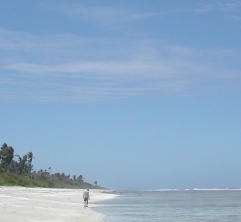
Walking the isolated beach
A few days after arriving here, our first Sunday here, we went to an umu (underground oven) potluck for the boaters that Sia hosts every Sunday out on Haukatu’utu’u Island. This is a little island that is part of the reef surrounding the anchorage. Sia prepares the entrees and side dishes in an umu, and she asks the boaters to bring desserts – especially anything chocolate. The tradeoff is that the boaters get to enjoy good food and a local experience, and Sia and her family get to enjoy desserts that they would not have without the boaters. Brownies and chocolate cake are huge hits!
A few days later, Don and Gwen invited us to go snorkeling. Nita (who loves diving but doesn’t particularly like snorkeling) was busy doing some inane chore, so she stayed on board, but Bud accepted the invitation and went along. The water outside the anchorage was glassy calm, and they could see humpback whales all around them. They jumped in the water to snorkel, and they were right on top of a cow and calf – about ten feet away. The whales didn’t stay around long, but it was an experience of a lifetime to see them up close like that.
We both did a few dives with the Tackless twosome, and we heard whale songs throughout our dives. During one dive, they sounded so close that we were constantly looking around to see them, but we did not.
We also rode our bicycles around the island one day in a few hours time. There is one dirt road in various states of repair that encircles the island. There are a few (four or five?) side roads that branch off it, and we explored each of those.There is a fresh water spring in Hihifa that runs through a natural crevice to the ocean. Although we didn’t get in it, it looks very inviting. We rode by the Royal Palace; however, it is not looking very ‘royal’ at present. There are pigs, chickens, and horses everywhere. The pigs and chickens run free, but most of the horses are lightly tethered. And there are mango trees. We have never seen so many mango trees, nor have we ever seen trees so loaded with fruit. We are just at the very beginning of mango season, so they are just ripening. There aren’t many things tastier than a tree-ripened mango. But the highlight of our bike ride was going to the isolated south shore beach. Very beautiful.
Although we don’t know why, there are about 20 vehicles on the island. We understand the hospital/health center having one to transport patients. And we understand the agriculture guys having a truck. But we cannot imagine why anyone would want to own a car here. Bicycles are much more practical.
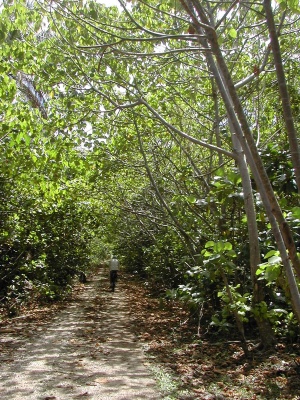
Riding down to the isolated south shore
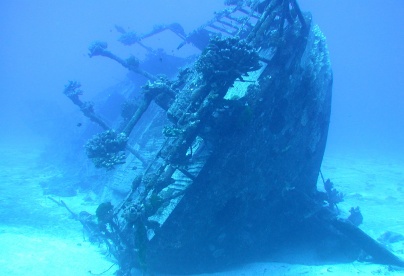
120′ steel sailing vessel down about 10 years
After being here for about ten days, Tackless II sailed on to the Vava’u group, but we stayed put. We were having a good time, but we weren’t yet having the types of experiences we wanted. We were not getting to know the local population like we wanted, so we made an effort to get to know Sia better, and we also got to know her husband, Niko. Then their three kids, then their extended family (Niko is one of twelve siblings and countless cousins), then we fell in love with this place.
Sia had told us that there was a steel sailboat wreck somewhere near offshore, and Niko knew about where it was. We wanted to dive on it. So our new friend, Mike (SV Integrity), Niko, and Bud set off to find it. It took a few hours, but they found it. They came in long enough to pick up Nita and dive gear, and all went out and dove it. We have been out there a few times, and it is a very cool dive.
Bud did a lot with Niko. He spent parts of a few days helping Niko fix a car window (yes, they own a car). Bud and our new friend Jim (SV Gaia) also spent a memorable evening drinking kava with Niko and a few hundred other local men. He was quite impressed by the music and the men’s singing. He even taught Jim and Niko how to brew beer (over a wood fire, of course – the only option here). A friendship christened by kava and homebrew…
Nita has unintentionally become known to seemingly every kid on the island. She takes lots of pictures of the kids, and now they all know her name and call to her as we ride our bikes.
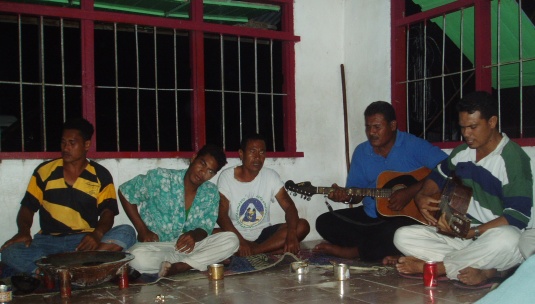
Music and kava
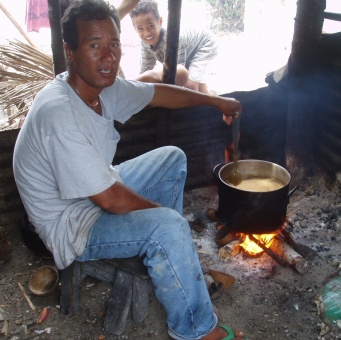
Niko brewing over an open flame
We have developed friendly relationships with three of the government officials that we met when we checked in, but we have come to know Sepe – the island’s physician – better than the others. Sepe is working under conditions that boggle our minds. The hospital/health center does not even have running water 24 hours per day! We also met the nurse-midwife, and her working conditions are equally arduous. This is tough duty out here.
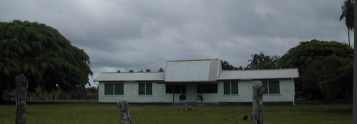
The ‘Royal Palace’ is looking a bit rough
A supply ship comes to the island fairly predictably every three months. When we were still in Samoa, we heard that the island was out of gasoline and rice until the next ship arrived.We do not have any way to carry gasoline, but we easily loaded 80 pounds of rice on board and brought it to give to whoever needed it. The customs agent, Bessie, distributed it for us. The supply ship arrived about two weeks later, so hopefully our small contribution helped tide over those that had run out. And what an experience it was when the ship arrived!
Ship day was a very festive day here. Many of the islanders came out and spent the entire day at the wharf watching the ship unload its cargo. We watched it unload its 55-gallon drums of gasoline with disbelief and fear. The drums were on a deck about 30 feet above the water. Like on Tin Can Island, the boat’s crew pushed the drums overboard. They fell 30 feet in to the water, and swimmers took them ashore. There were swimmers in the water when the drums were being thrown overboard, but fortunately no one was hit by a falling drum. Also, fortunately no two drums collided which could have caused leaks and/or sparks. A very dangerous way to unload fuel.
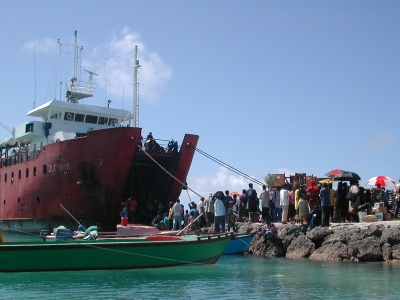
The supply ship is cause for lots of festivity!
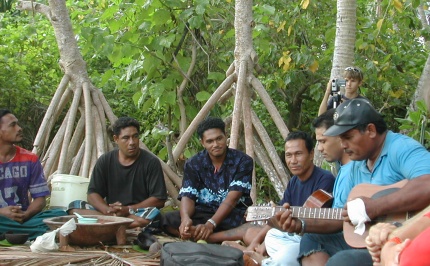
Our hosts & entertainment for a co-ed evening of kava
And then there was the feast… Anyone who has spent time in the South Pacific has heard about Tongan feasts, and we had the pleasure to attend one. It was a busy day, and we took lots of pictures. So, in an effort to keep this page from getting even longer, we will describe the feast and post a few pictures on a separate page. You can follow this link to the Tongan Feast.
Although most of the cruising men had participated in at least one kava ceremony (Jim and Bud and a few more), they were not clear about the various traditions. And the women were excluded from participating, so they knew nothing about it other than that the men sure seemed to like it. So we talked to Niko and Sia, and they arranged a kava ceremony out on the motu just for the cruisers – including women! We had kava, music (the same seven men that had charmed Bud with their singing at a previous kava ceremony he attended with Jim), and story-telling about the traditions behind Tongans drinking kava. It was a wonderful evening.
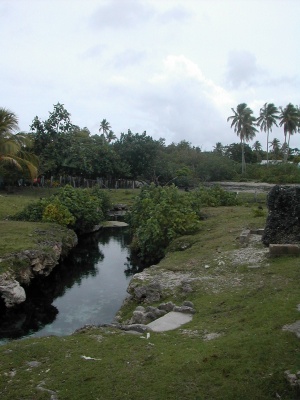
Niutoua fresh water spring
And finally, we had one exciting day and evening that reminded us that we are lucky to live among such a fine community of cruisers. Our new friend, Michael (SV Yonita) became terribly ill with a urinary tract problem. We got the local physician, Sepe, involved, but she could not help him. He needed a urologist. So the cruisers in the anchorage and those within reach of our radios set to getting him to a urologist asap (Planes cannot fly in to Niuatoputapu. The nearest airport is in Neiafu – 163 miles south.). Some took care of radio contacts and making evacuation plans. Some offered medical supplies and medications. Some offered to help get his boat to Neiafu. Others offered anything he needed. And he did, indeed, get to Neiafu, then on to Los Angeles where he is currently being worked up. It was comforting to know that our friends and neighbors – even those that we may not have met yet – will help in every way they can if/when we ever need it. We have some fine friends and neighbors.
But it was finally time to move on. What we will always remember about this island is the friendliness of its people. We have felt welcomed in to people’s lives and homes here. After being here a few weeks, people seemed to make an effort to acquaint themselves with us. They were not looking for what they could get from us other than our time and friendship. We have shared time and friendship with the local population here, and we have made friends that we will always remember. This is a special place populated with truly special people. This is why we are cruising the south pacific.
Return to our Niuas page.